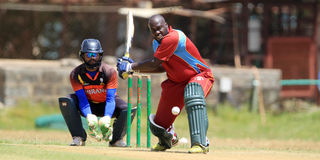Kenya seemingly excelled in cricket in the 1990s and 2000s by accident

Obuya Academy A's Collins Obuya (right) bats as Ruaraka A's Chandresh Hirani looks on during their Nairobi Provincial Cricket Association (NPCA) T20 Super Cup match at Ruaraka Sports Club on February 20, 2022.
What you need to know:
- Interestingly, a majority of the, particularly African players of that generation, picked up the game of cricket by chance.
It was considered the greatest upset in cricket history then when Kenya stunned the mighty West Indies in the 1996 Cricket World Cup co-hosted by India and Pakistan.
Any genuine Kenyan cricket fan will be familiar with the Indian town, Pune, where that upset of seismic proportions took place on February 29.
West Indies were two-time world champions and three-time finalists, while tiny Kenya were making their maiden World Cup appearance and had not even acquired ODI status.
In that great West Indies team were, Brian Lara, considered the best batsman of his generation, Roger Harper, and the fearsome pace bowlers Ian Bishop, Curtly Ambrose and Courtney Walsh.
Kenya, batting first were scuttled on 166 runs and then went on to bowl out the Caribbean inhabitants for 93 for a 73 runs famous victory to announce their entry to the world of elite cricket.
In that team were flamboyant Maurice Odumbe, who was named man of the match, mean seamer Martin Suji, prolific batsman Steve Tikolo, deadly spinner Asif Karim, formidable all-rounder Thomas Odoyo, swashbuckling Kennedy Otieno, solid Hitesh Modi, Dipak Chudasama, Tariq Iqbal, Rajap Ali and Tito Odumbe.
The core of this team, that got ODI status soon after the 1996 World Cup, went on to ruffle the established order whenever they got a chance to play with the big boys.
Twice, Kenya beat giants India in ODI encounters, by 69 runs at Roop Singh Stadium, Gwalior on May 28, 1998 and by 70 runs on October 17, 2001 at St George's Park, Port Elizabeth in South Africa.
Kenya’s best cricket moments undoubtedly came at the 2003 World Cup that we co-hosted with South Africa and Zimbabwe.
Kenya became the first non-Test playing nation to reach the semi-final, famously beating Sri Lanka in Nairobi together with Canada, Bangladesh and Zimbabwe in the process.
Knocking at Test status
The country was once ranked 10th in ODI and knocking on the door of Test status before things started steadily going south.
The ODI status was lost in 2014 seemingly for good.
Late last month and early this month, I watched Kenya, now placed 30th in the ICC Twenty Rankings, thumped 3-2 by Nepal in Nairobi in a five-match T20 series and then whitewashed 3-0 by the South Asians in a three-match ODI series.
I was horrified to see minnows Tanzania chase down Kenya’s 155 in their ACA T20 Cup Finals match to eventually win by four wickets at Willowmoore Park, Benoni, in South Africa on Saturday.
Kenya, at one time the best cricket playing nation in Africa after Test playing South Africa, is now fodder for cricket midgets the likes of, and this is no slight to them, our neigbours Uganda, Tanzania and Rwanda.
To be frank, and I will admit I am clouded by misty recollection of a glorious past, I saw a team lacking in comparable, skill, guile and purpose of the yesteryear side.
How is it that we have sunk to this depth where our peers are Malawi, Nigeria, Ghana, Mozambique?
Was it an accident that formed that achieving team of the 1990s and early 2000s?
Interestingly, a majority of the, particularly African players of that generation, picked up the game of cricket by chance.
It has been written of how, for instance, the Tikolos, Odumbes and Sujis, born and bred in Park Road, Nairobi, used to go watch cricket at the neighbouring Sir Ali Muslim Club.
Like young animals learning through imprinting, they would then try out batting and bowling on the estate alleys or at the cricket club, whenever permitted.
You can say they did not go through a national, established development structure.
Cricket was mainly a Nairobi and Mombasa affair, and that has not changed much to date.
While others, once considered elite sports in Kenya such as rugby are now, thanks to concerted development programmes, as common as the people’s sport – football, and are played in virtually all schools, cricket is still not part of the official Kenya Secondary School Games annual calendar.
Is this not a travesty for a sport that once held so much promise in this country?
Startling revelation
Former captain Karim, who retired after the 1999 World Cup only to make a comeback, in an interview with espncricinfo.com in 2014 made a startling revelation:
“When they called me in December 2002, there were some problems in the Kenyan team.
“It is not an easy team to handle. You have Asians, Indians and Africans. Among the Indians and Asians, you have Hindus and Muslims, and among the Africans, you have 42 different tribes. To mix the team, it is very unique.
“I retired after the 1999 World Cup because of all the politics. I knew there was going to be a huge problem because of leadership and the pressures of international cricket.”
Is that still the case with the motley of personalities in the Kenya team?
Would it be the reason why several of Kenya’s former top players are now coaching outside the country?
Kenya's got talent, obviously, but it has not been adequately reared and harvested.
It is an irony that a game that previously brought much joy and pride to Kenyans is now a source of anguish and consternation. Like football.





